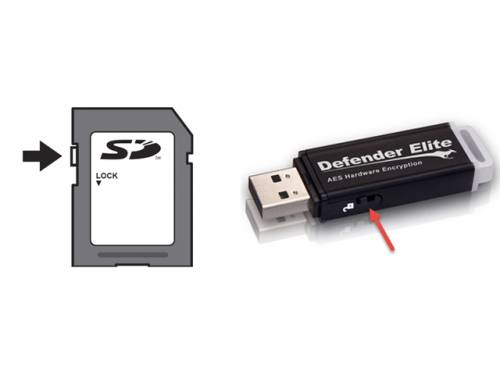Fix the disk is write protected error (6 definitive methods)
The disk is Write Protected error is related to USB or SD card in Windows 7, 8, and 10. Many users have seen this error message in the Windows operating system when transferring data to a USB or SD card. You can fix this problem quickly by removing the write protection from USB or memory cards.
In this tutorial, we will look at the following:
What’s the “The Disk is Write Protected” error?
- Causes of error
- How to remove write protection from USB
- Solution 1: USB format or SD card
- Solution 2: Check for USB drive viruses
- Solution 3: Enable reading mode
- Solution 4: Change the file type
- Solution 5: Update USB drivers and card reader drivers
- Solution 6: Edit registry files
- Conclusion
What’s the “The Disk is Write Protected” error?
This is a common error in Windows 10, which is why many users have encountered this error. When copying a file or folder in Windows, this error occurs with the following text: “The Disk is Write Protected. Remove or Use Another Disk, which means “The disk is protected from writing.” “Delete or use another disk.”
By following this article, you can identify the cause of this error and fix it easily.
Causes of error
After conducting in-depth research on this error, we finally found some reasons for it:
Problem with the USB drive or SD card and card reader The USB drive or SD card may have a problem. Also, check the card reader for the SD card.
Physical problems There are many reasons for this error, but most likely to the device itself. The device may be physically unstable or infected with spyware or other viruses. Therefore, you must first diagnose the problem of the device. For example, some brands of these drives do not perform well, which will lead to minor bugs in the software or hardware. In this case, just replacing the device solves the problem.
Malware Sometimes, malware can turn a drive into a read-only drive. In such cases, you have two choices: either you can remove the malware or virus manually using antivirus software, or you can use software removal software. Manually removing the program may not be very effective because sometimes the malware is hidden deep in the system files. So it would help if you used advanced malware protection software like Malwarebytes to fix the problem.
Computer failure is one of the most common reasons a USB drive is read-only. It would be best to use a computer repair tool to fix any drive problems such as bad sectors or missing file descriptors.
Some SD cards and USB drives have a physical switch for enabling and disabling read-only features.
Security sometimes blocks Windows, USB, or SD card firewalls. You must change the security settings in the registry.
Drive Problems Old or obsolete drivers can also cause this error.
Whatever the reason, you can easily solve this problem in a few simple steps. Let’s get started!
Problem-solving methods
First, make sure the USB or SD card is working. To connect them to another system. If USB works well with the system, the problem is with your system, not the USB drive or SD card.
Also, check if you are using a card reader.
Solution 1: USB or SD Card format
The first step is to format the drive. There are three ways to format a drive:
1- Using File Explorer
Step 1: Right-click on your USB drive in File Explorer, then click Format.
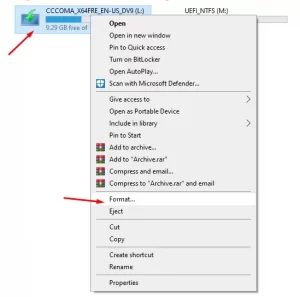
Step 2: Now select the recovery settings (Restore device defaults option) and click Start.
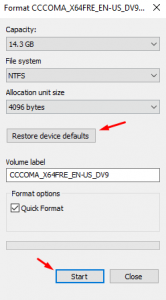
As a result, formatting the USB or SD card empties and erases them. So all the problems related to malware and memory will be fixed
2- Diskpart tool
The Diskpart tool is the next way to format a drive. Follow these steps to use this tool:
- Type cmd in the search option (bottom left of Windows), open it as Run as administrator, type “diskpart,” then press Enter.
- Click yes for the question asked. As a result, the diskpart tool opens.
- Type “list volume” and press Enter.
- Now type “select volume 11” to select your device. (Here, the number 11 indicates the USB drive in my system, you select the number from your system)
- Now type the command format fs = ntfs label = “new volume quick” and press Enter.
- Finally, it automatically formats the drive.
3- Disk Management tool
Disk Management is another internal tool for managing internal and external storage devices. Follow these steps:
Step 1: In the System Start menu, search for “create” and select “Create and format hard disk partitions.”
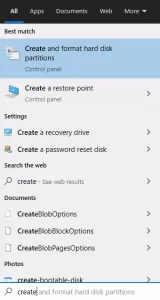
Step 2: Find the USB device here and right-click on it.
Step 3: In the window that opens, enter the formatting options and click Ok.
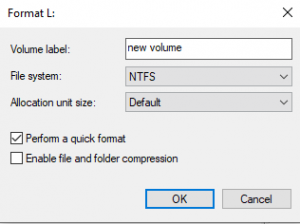
Solution 2: Check for USB drive viruses
As mentioned earlier, spyware and malware can cause this error. So try scanning your USB drive with antivirus and anti-malware software. You can use Windows Defender or Malwarebytes to scan the device. Or install one of these free antiviruses on your system.
Solution 3: Enable reading mode
Many external devices, such as USB drives or SD cards, have a physical button to lock or unlock the read mode. So check if this lock is active or not.
Solution 4: Change the file type
Make sure the file you want to copy is not read-only. You can check this using property.
Step 1: Right-click on the file or folder and click on the last Properties option.
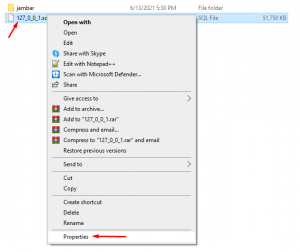
Step 2: Check the Read-only option. If it is enabled, uncheck it and click Apply.
Solution 5: Update USB drivers and card reader drivers
Old or broken drivers also increase the risk of this error. As a result, you need to update your drivers.
You can download and install the USB driver manually from the manufacturer’s website.
Or use driver update software such as driver easy (download link) to update drivers automatically.
Solution 6: Edit registry files
Follow the steps below to open the Registry Editor:
Step 1: On the search option (bottom left of Windows), type “Regedit” and press Enter. The Registry Editor opens.
Step 2: Go to the following path:
HKEY_LOCAL_MACHINE \ SYSTEM \ CurrentControlSet \ Control \ StorageDevicePolicies
If this key is not available, create a new key.
From Control> select New> Key, create a new key and rename it to StorageDevicePolicies.
Select the StorageDevicePolicies key and then right-click on a space. Select the DWORD (32-bit) Value value from the New menu.
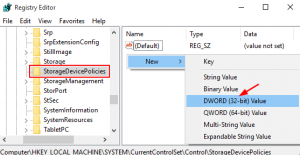
Could you enter the name WriteProtect for it?
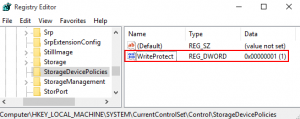
Double-click WriteProtect and change the data value from 0 to 1.
Now disconnect the flash from the system and reconnect. It should work.
Conclusion
Disk protection error is very common among Windows users because there are many problems with drivers and operating system compatibility. The above methods will solve the problem.
